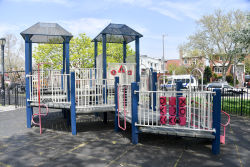Dyker Beach Park
The Daily Plant : Thursday, August 26, 2004
WANT “BILL AND TED” HISTORY, BUT DON’T HAVE A PHONE BOOTH? USE A PARK!
If I were to say to you, "you know that movie where Keanu Reeves travels around by phone booth?" you might first think of Neo in The Matrix. But if you let your mind roll back another ten years, you’d get to the slightly less acclaimed Reeves film, Bill and Ted’s Excellent Adventure, in which he played Ted, a failing high school student who, with the help of Rufus (played by George Carlin) travels to the past in a time machine/phone booth.
Now, if Rufus were to show up on our doorstep today and we could "Bill and Ted It" back 228 years exactly, we too would have an excellent adventure, and our phone booth would never have to leave parkland. August 26, 1776 marked the official beginning of the Battle of Brooklyn, which in turn was the first full-scale battle of the American Revolution. Were we to transport ourselves back to that day on the land that is now John Paul Jones Park, in Bay Ridge, Brooklyn, we would see before us the masts of more than 300 ships of the British Royal Navy. It was the greatest armada ever assembled (more than twice as many ships as the famed Spanish Armada), and being so far from home, constituted a foreign deployment unprecedented in scale.
The British hoped for a short war, assuming that the Colonial rebels would quickly collapse after merely seeing such a massive force. The ships had been coming in for more than a month, carrying soldiers from England, Scotland, and Hesse-Cassel, now part of Germany. More than 20,000 trained fighting men took on 8,000 rebels, few of whom were true soldiers—most were loosely organized farmers and hunters.
George Washington, who called himself "General" but whom the British commanders considered a civilian combatant, could watch the masts multiply from the fort that stood at what is now the entrance to Battery Park as well as from his fortifications at Brooklyn Heights (now the Promenade). On August 22 he saw the first landing at Gravesend Bay (Dyker Beach Park) in Brooklyn. Trained by the British himself, he knew the invaders would either come up Shore Road and Flatbush Avenue (to what is now Prospect Park) or the King’s Highway and around Jamaica Road (now Eastern Parkway). The trick was how best to organize a rag-tag army to defend his fledging country’s most strategically important city.
Contrary to what one might assume, and yet in keeping with our present-day dispositions, New Yorkers generally opposed the war. They just wanted to "go about their daily business" and looked forward to the American surrender—some even passed information to the British in order to expedite the rebellion’s inevitable failure. The British called them loyalists and assumed that they comprised a "silent majority."
Ultimately, fighting the world’s greatest sea power on an archipelago city proved futile. Perhaps the most notable episode in the Battle of Brooklyn was the bravery of the 400 Marylanders who held off thousands of British at the Vechte-Courtelyou House, now the Old Stone House in the present-day J.J. Byrne Park. Having fought nearly to the last man, their courageous efforts allowed the bulk of the rebel army to escape. Those soldiers who died are remembered with a monument in Prospect Park.
Due to the fact that the British had total control of New York City throughout the war, they were able to imprison both soldiers and civilians on hulks in New York harbor. The 11,500 men and women colonialists who died in that harbor are remembered in the Prison Ship Martyrs’ Memorial in Fort Greene Park. There are many other important American Revolution sites that survive around the city, and more often than not, they’re located on parkland. You can find them by reading the park histories (Historical Signs) on our website, and then you too can plan out your own "excellent adventure."
Written by John Mattera
QUOTATION FOR THE DAY
"Good music is very close to primitive language."
Denis Diderot
(1713-1784)
Check out your park's Vital Signs
Clean & Safe
Green & Resilient
Empowered & Engaged Users
Share your feedback or learn more about how this park is part of a
Vital Park System










